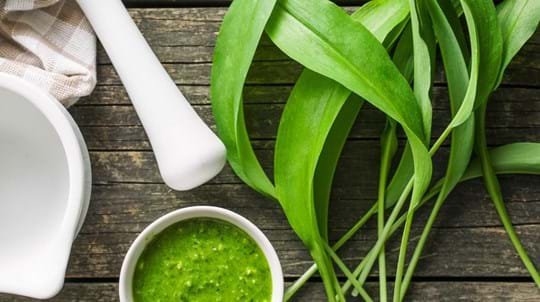Give back to nature
Experiment with your foraged finds in style. Every purchase from our kitchen and dining range helps fund our vital work to plant and protect trees and woods across the UK.
Shop now
Content manager, botanist and tree lover
It may feel like we’re still in the grips of winter, but shoots are starting to appear. And they’re growing quickly.
Here are some early spring plants and winter fungi to look out for.
Always take a good field guide with you and please follow our sustainable foraging guidelines, including only picking from plentiful sources and only foraging what you can identify with certainty.
Also known as horse parsley, alexanders is a biennial plant and believed by some to be one of the best wild vegetables of spring. It’s not native and was introduced to the UK by the Romans.
How to use it: every part of it is edible but the succulent stem is the best bit. People say it tastes similar to angelica and parsley, but there are many different ways to bring out its flavour. You can steam or boil them, toss in butter and season with black pepper. Leaves and flowers are also edible - add them to salads.
What to look for: it’s particularly widespread in coastal regions in the south of England. Look along cliff tops and hedgerows. You can pick the stems from February but they’re at their best when the first flower buds appear in late March and April.
Take care: be careful not to confuse this with other umbellifers (plants in the Apiaceae family). Some species, like hemlock, are extremely poisonous.
Chickweed is an overlooked but underrated weed with cleansing and healing properties and is packed full of vitamins and minerals.
How to use it: its tender leaves can go in salads with lemon and olive oil dressing. Blend into homemade pesto, or use to liven up fish or chicken. The tiny white, edible flowers make a pretty salad garnish.
What to look for: it’s a tough, creeping annual common throughout the UK on waste ground and in gardens. It’s abundant throughout the year from spring to late autumn. Look for its small, white, star-like white flowers. Look for it from February.
The name of this plant literally means lion’s tooth (dent de lion) probably referring to its jagged leaf edges. It’s long been associated with folklore and herbal medicine and is probably best known for its diuretic effect.
How to use it: all parts of this slightly bitter plant are edible, both raw and cooked. Add young leaves to salads, sandwiches or pies. Flowers can be used in many dishes from risotto to omelettes, for decoration and to make beer and wine. Unopened buds can be marinated and used like capers. Roots can also be thrown into stir-fries or added to vegetable dishes or try making dandelion coffee by drying then grinding the roots.
What to look for: really common, easy to identify and found almost everywhere. Young leaves from the centre of the rosette are best – the dark outer leaves may be too bitter. The first of the dandelions appear in February.
Nettle leaves are a surprisingly versatile ingredient and are reputed to be a great superfood that’s rich in iron and vitamins A and D and packed with minerals. New growth usually begins to appear in early February.
How to use it: the favoured leaves to pick are the tips – they’re tender and give the best flavour. You can use gloves to avoid being stung. The leaves have a flavour somewhere between cabbage and spinach. You can use nettle in the same way as spinach or to make tea, beer or soup (try creamy nettle and potato).
What to look for: it’s an unmistakable plant familiar to everyone. It grows pretty much everywhere. Just remember to avoid roadside and pesticide-ridden areas. It’s best picked from late February to early June.
Early in the spring the small, fragrant violets begin popping up. Its flowers have been used in the making of perfume as far back as Classical Greece and as a household deodorant in medieval Britain. Sweet violets are becoming less common in the UK, probably due to overpicking. If you want to use them regularly, consider growing them in your garden.
How to use it: the flowers have been used to flavour sweets (parma violets), chocolates and creams. Try crystallising the flowers or use them to infuse milk puddings. The young leaves are said to be edible too and apparently contain large amounts of vitamin A.
What to look for: it prefers more open habitats, by the side of paths, in hedges and scrub as well as woods. You can recognise it by its large, hairy heart-shaped leaves. Sweet violets start flowering as early as February.
Commonly known as velvet shank, you’ll find the lovely orange-brown caps of this species fruiting through the winter. Its scientific name means ‘little flaming velvet leg’ which is exactly what the stems of these mushrooms look and feel like.
What to look for: velvet shank mushrooms are saprophytic living on dead and decaying trees. Look for it on stumps and trunks of dead hardwood trees, particularly ash, beech and oak. Look for caramel to orange coloured caps (3-7cm across when fully grown), growing in overlapping tiers. Take care when identifying as they look similar to other species, including the deadly funeral bell. But their growing season rarely overlaps so it’s unlikely you’ll get confused. Look out for it between November and March.
Wild garlic, also known as ramsons, is a native bulb that often grows in dense clusters on the floor of damp woodland and along shaded hedgerows. It’s a rich source of folklore and is credited with the ability to ward off vampires and evil spirits.
How to use it: the leaves and flowers are edible and delicious and have an unmistakable smell. The flavour is mellower than that of cultivated garlic and can be used in many ways. Add leaves to soups, sauces or omelettes. Whizz them into a wild garlic pesto or use to infuse olive oil. They are also delicious in salads and sandwiches.
What to look for: common throughout woodland in England and Wales, but less so in Scotland. Leaves appear as early as February and are best picked before the flowers have died (usually early May). Its white, star-like flowers make an appearance in April.
Experiment with your foraged finds in style. Every purchase from our kitchen and dining range helps fund our vital work to plant and protect trees and woods across the UK.
Shop now
Visiting woods
See what's in season with our guide to sustainable foraging with top tips on how to pick, cook and eat wild plants.

Visiting woods
Our favourite foraging recipes using wild harvested plants from the British countryside.

Blog
Laura Cottam • 26 Apr 2019